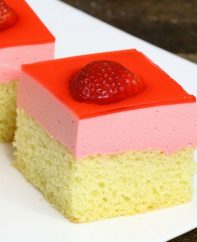What is Mirin and Mirin Substitutes
This post may contain affiliate links. Please read the disclosure policy.
Mirin (味醂 or みりん in Japanese) is a Japanese cooking rice wine with subtle sweet accents that make many dishes such as teriyaki chicken, ramen and udon. It’s a common ingredient in Japanese cooking and works very well when mixed with soy sauce.
This quick 3-ingredient homemade mirin works perfectly as a substitute for teriyaki and other recipes calling for mirin. All you need is sake, sugar and water to make it.
What is Mirin?
Mirin is a type of Japanese sweet rice wine that is commonly used in Asian cuisine. It is made from glutinous rice that has been fermented with koji, a type of fungus used in the production of many Japanese fermented foods.
It has a sweet, slightly tangy flavor and is often used as a seasoning in dishes such as teriyaki sauce, sukiyaki, and marinades for fish and meat. It is also used to add a subtle sweetness to dishes like miso soup and stir-fries.
What is Mirin sauce made of?
Mirin sauce typically consists of mirin, soy sauce, and sugar. The proportion of each ingredient may vary depending on the brand. Some variations may include additional ingredients such as ginger, garlic, or sake.
You can make mirin sauce easily at home. The ingredients are usually mixed together and simmered over low heat until the mixture is reduced to a thick and syrupy consistency. Mirin sauce is commonly used as a marinade for fish or meat, as a dipping sauce for sushi, or as a glaze for grilled or broiled dishes.
What does Mirin taste like
Mirin tastes a little like sake, but it’s sweeter and has a lower alcohol content (about 14%), a bit like dessert wine but more subtle. Don’t worry about the alcohol, as it burns off during cooking.
Mirin can transform bland sauces into something very flavorful. For example, the classic teriyaki sauce is essentially made with mirin, sake, soy sauce and sugar.
Mirin vs rice vinegar
Both mirin and rice vinegar are commonly used in Asian cuisine and have similar flavor profiles, but they are also quite different.
Mirin is a sweet rice wine that is often used to add a mild sweetness to dishes. It is often used in marinades, sauces, and glazes. Mirin has a lower acidity than rice vinegar, and its sugar content helps to caramelize the outside of foods and give them a glossy finish.
Rice vinegar is made from fermented rice and has a more sour taste. It is used to add acidity to dishes and is a common ingredient in sushi rice, pickles, and salads. Rice vinegar can also be used as a substitute for other types of vinegar in recipes.
Types of Mirin
There are different types of mirin available in the market, each with its own unique taste and purpose. Here are some of the most common types of mirin.
1. Hon mirin
This is the most authentic and traditional type of mirin. It’s made from glutinous rice, koji mold, and shochu. Hon mirin has a rich, sweet flavor and is used to add depth to dishes such as teriyaki and sukiyaki.
2. Shin mirin
Also known as mirin-fu chomiryo, this type of mirin is a modern version of hon mirin. It contains less alcohol and sugar than hon mirin and is used mainly for cooking, rather than as a condiment.
3. Aji mirin
Aji mirin is a type of mirin that has been mixed with salt, vinegar, and other flavorings to create a condiment that can be used in place of regular mirin. It is often used in marinades, dressings, and dipping sauces.
4. Mirin-type seasoning
This is a non-alcoholic mirin substitute that is made from a blend of sweeteners, vinegar, and other flavorings. It is commonly used in dishes that require the flavor of mirin but where the alcohol content is unwanted or unsuitable.
Mirin brands
There are a number of brands of mirin available in the U.S., although authentic Japanese hon-mirin is difficult to track down. Here are some of the most commonly available brands:
| Brand | Ingredients | Sugar per tbsp |
| Kikkoman | Glucose syrup, water, alcohol, rice, corn syrup, salt | 7-8 grams |
| Sushi Chef | Fructose, water, rice, distilled sake, and rice koji (enzyme modified). | 5 grams |
| Eden | Water, organic rice, koji (aspergillus oryzae), sea salt | 4 grams |
Kikkoman is probably the most the common mirin brand, with both its original Aji-Mirin and its newer Kotteri Mirin. The flavor is delicious, although it’s also the sweetest at 7-8 grams of sugar per tablespoon. It also contains corn syrup, which some people dislike.
Eden Mirin is the only major brand of mirin with no refined sugar added, and it’s made with organic rice too. Eden Mirin is likely the best option for diabetic or sugar-reduced diets.
Ways to use Mirin
There are so many delicious ways to use Mirin such as adding it to sauces, marinades, and glazes to add sweetness and depth of flavor.
- Use it as a seasoning: Mirin can be used as a seasoning for many dishes, such as stir-fries, stews, and soups.
- Add it to marinades: Mirin can be used as an ingredient in marinades to add flavor and tenderize meats. Mix mirin with soy sauce, ginger, and garlic for a delicious marinade for chicken or beef.
- As a dipping sauce: Mirin can be used as a base for dipping sauces for sushi, tempura, or other dishes. Mix mirin with soy sauce and rice vinegar for a simple and tasty dipping sauce.
- Use it in glazes: Mirin is often used in glazes for grilled or baked fish and meat. Mix mirin with soy sauce and honey for a flavorful glaze that will caramelize beautifully.
Where to buy mirin
You can find it in many grocery stores and supermarkets, usually in the Asian sauces section. If that doesn’t work try ordering it online.
It costs about $5-10 per bottle depending on the brand, and it will quickly become a staple in your kitchen.
What are substitutes for mirin
1. Sake
Similar in taste to mirin, sake can be used as a substitute. Note that because it is not as sweet as mirin, you may need to add a sweetener to your recipe. If you’re looking for a substitute that doesn’t have alcohol, a wine vinegar would be a better choice.
2. Cooking Sherry
Dry sherry will add a depth of flavor to your dish that’s similar to mirin. It is also light enough to complement the dish instead of overpowering it.
3. White Wine
White wine is an easy-to-source replacement for mirin. Choose a dry wine instead of one that’s sweet. You may want to add a touch of sweetener to balance the flavors of the dish.
4. Rice Wine Vinegar
This is a good option if you’re looking for an alcohol-free substitute. Mix the vinegar with the granulated sugar at a ratio of 1 part vinegar to .5 part sugar.
5. White Wine Vinegar
White wine vinegar has a slightly acidic flavor and is a good substitute for mirin. Because of its tangy flavor, you may want to balance it with the addition of a sweetener.
Popular recipes using Mirin
FAQ
What’s the difference between Mirin and sake?
Both Mirin and sake are traditional Japanese alcoholic beverages, but they have different uses and flavor profiles. Mirin has a lower alcohol content than sake, typically around 14% alcohol by volume. It has a sweet, syrupy flavor and is commonly used in teriyaki sauce, sukiyaki, and other Japanese dishes.
Sake is a fermented rice wine that is commonly consumed as a drink. It is typically served chilled or warm and has an alcohol content that ranges from 15% to 20% alcohol by volume. Sake is made from polished rice that is fermented with koji and water. It has a complex flavor profile that can vary depending on the type of rice used, the water source, and the brewing method. Sake is often served with sushi, sashimi, or other Japanese dishes.
What are the key ingredients in Mirin?
The key ingredients in mirin are rice, koji (a type of fungus used in fermentation), and shochu (a distilled beverage made from rice, barley, or sweet potatoes).
The process of making mirin involves steaming and fermenting the rice, then adding koji and shochu to the mixture. The resulting liquid is aged for several months to develop its distinctive flavor and aroma.
Homemade Mirin Recipe
Ingredients
- 1/4 cup granulated sugar
- 3 tbsp water
- 3/4 cup sake wine
Instructions
- Add sugar and water to a small saucepan and place over medium heat.
- Bring to a boil, and allow to boil gently for 2-3 minutes. Then remove from heat.
- Dribble in the sake slowly until you reach the desired level of sweetness.
- Stir to mix and set aside to cool completely. Store in a mason jar in the fridge.
Notes
Please read our nutrition disclaimer.
© TIPBUZZ. Images and text on this website are copyright protected. Please do not post or republish without permission. If you want to republish this recipe, please link back to this post. This post may contain affiliate links. Read the disclosure policy here.












Gosh I’ve never tasted Mirin straight from the bottle so have zero clue as to what is considered the proper sweetness level. This was a great help to me thank you.
Hi Pam, Thanks for your feedback and glad to hear.
can also use rice syrup, makes it closer to real sweet sake.
If I have kome-koji I add 50g per litre and soak for a few days, can use it afterwards for amazake actually.
Adam
Thanks for mirin tips.
Hi Roz, Happy to help and thanks for your comment!
Can peach flavor sake be used? I don’t have any regular sake.
Hi Maly, Thanks for your comment. You wouldn’t want peach flavor in your savory dishes unfortunately! Try making the substitute recipe instead…
I always try to keep a bottle of mirin in my pantry but occasionally I forget, so this recipe will be so handy in the future, thank you!
Mirin is wonderful in cooking! Just a touch makes a real difference. Thanks for the brand breakdown – I’m rather astonished that Kikkoman doesn’t use koji!
I love to cook for the family and I’m always looking for tips to cut costs. This version of mirin is so much cheaper than store-bought brands. I’ll be making a big batch of this to use throughout the year!
I have never tried using this before. Thanks for sharing. Saving it for later.
We love mirin and use it often when cooking! Thanks for the great substitute recipe for when I run out!
Huh. I have never tried this before. Maybe I will do a late night Amazon shopping spree tonight and buy this!
Thanks Cathleen, mirin’s the secret to the best teriyaki! Once you taste it, you’ll never go back 🙂